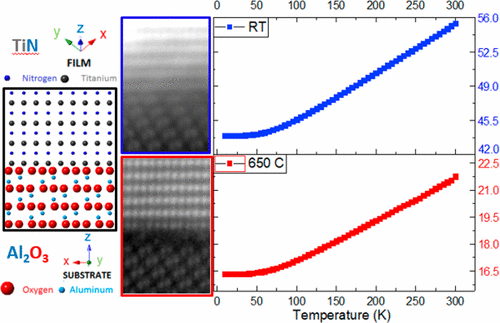当前位置:
X-MOL 学术
›
Cryst. Growth Des.
›
论文详情
Our official English website, www.x-mol.net, welcomes your
feedback! (Note: you will need to create a separate account there.)
Room Temperature Growth of Epitaxial Titanium Nitride Films by Pulsed Laser Deposition
Crystal Growth & Design ( IF 3.2 ) Pub Date : 2017-10-30 00:00:00 , DOI: 10.1021/acs.cgd.7b01278 Daniel Rasic 1 , Ritesh Sachan 1, 2 , Matthew F. Chisholm 3 , John Prater 2 , Jagdish Narayan 1
Crystal Growth & Design ( IF 3.2 ) Pub Date : 2017-10-30 00:00:00 , DOI: 10.1021/acs.cgd.7b01278 Daniel Rasic 1 , Ritesh Sachan 1, 2 , Matthew F. Chisholm 3 , John Prater 2 , Jagdish Narayan 1
Affiliation

|
Reducing the thermal budget of epitaxial thin film growth has been one of the biggest challenges for the electronics industry. In this report, the room-temperature epitaxial growth of titanium nitride (TiN) thin films (∼75 nm) on (0001) Al2O3 substrates is demonstrated using a pulsed laser deposition technique. In TiN thin films, the epitaxial relationship is established by X-ray diffraction for (111)TiN//(0001) Al2O3 and <11̅0>TiN // < 101̅0> Al2O3 which corresponds to a 30° rotation of titanium and nitrogen atoms with respect to the hexagon arrangement of aluminum atoms. An increase in the defect concentration is shown in the room-temperature thin film growth as compared to the ones grown at elevated temperature. A shift and broadening of the diffraction peaks is observed in the thin films as compared to the bulk value, indicating a higher residual tensile strain with decreasing growth temperature and an increase in defect concentration at room temperature. The increased defect concentration observed at lower growth temperature is explained by the lower energy budget that limits defect recombination and film relaxation. The residual strain in all films is dominated by the lattice mismatch (∼8.46% misfit) and defects, and not due to the thermal expansion mismatch, as Al2O3 and TiN have similar coefficients of thermal expansion. Raman spectroscopy measurements also confirm an increased concentration of vacancies in TiN films grown at lower temperature. Using atomic resolution scanning transmission electron microscopy, it is shown that the room-temperature grown films contain a lower density of periodic dislocations at the film/substrate interface, a characteristic of the large misfit systems, but have more dislocations trapped within the film. The lower density of dislocations near the film–substrate interface signifies incomplete relaxation at lower temperatures. In view of more defects in the film, resistivity of the film grown at room temperature is ∼55 μΩ·cm as compared to ∼22 μΩ·cm for films grown at 650 °C, showing a similar performance at a reduced thermal budget.
中文翻译:

脉冲激光沉积在室温下生长外延氮化钛薄膜
减少外延薄膜生长的热预算一直是电子工业的最大挑战之一。在此报告中,使用脉冲激光沉积技术证明了在(0001)Al 2 O 3衬底上室温氮化钛(TiN)薄膜(〜75 nm)的室温外延生长。在TiN薄膜中,通过X射线衍射可以确定(111)TiN //(0001)Al 2 O 3和<11̅0> TiN // <101̅0> Al 2 O 3的外延关系。这对应于钛和氮原子相对于铝原子的六边形排列旋转了30°。与在高温下生长的薄膜相比,室温薄膜的生长显示出缺陷浓度的增加。与体积值相比,在薄膜中观察到衍射峰的移动和展宽,表明随着生长温度的降低和室温下缺陷浓度的增加,残余拉伸应变更高。在较低的生长温度下观察到的缺陷浓度增加是由较低的能量预算所解释的,该能量预算限制了缺陷的复合和膜的松弛。所有薄膜中的残余应变均受晶格失配(〜8.46%失配)和缺陷的影响,而不是由于热膨胀失配(如Al)2 ö 3TiN和TiN具有相似的热膨胀系数。拉曼光谱测量还证实了在较低温度下生长的TiN薄膜中空位浓度的增加。使用原子分辨率扫描透射电子显微镜,表明室温生长的膜在膜/基底界面处具有较低的周期性位错密度,这是大型失配系统的特征,但是在膜内捕获的位错更多。薄膜-基底界面附近的位错密度较低,表明在较低温度下弛豫不完全。考虑到膜中的缺陷更多,与在650°C下生长的膜的〜22μΩ·cm相比,在室温下生长的膜的电阻率为〜55μΩ·cm,在降低的热预算下显示出相似的性能。
更新日期:2017-10-31
中文翻译:

脉冲激光沉积在室温下生长外延氮化钛薄膜
减少外延薄膜生长的热预算一直是电子工业的最大挑战之一。在此报告中,使用脉冲激光沉积技术证明了在(0001)Al 2 O 3衬底上室温氮化钛(TiN)薄膜(〜75 nm)的室温外延生长。在TiN薄膜中,通过X射线衍射可以确定(111)TiN //(0001)Al 2 O 3和<11̅0> TiN // <101̅0> Al 2 O 3的外延关系。这对应于钛和氮原子相对于铝原子的六边形排列旋转了30°。与在高温下生长的薄膜相比,室温薄膜的生长显示出缺陷浓度的增加。与体积值相比,在薄膜中观察到衍射峰的移动和展宽,表明随着生长温度的降低和室温下缺陷浓度的增加,残余拉伸应变更高。在较低的生长温度下观察到的缺陷浓度增加是由较低的能量预算所解释的,该能量预算限制了缺陷的复合和膜的松弛。所有薄膜中的残余应变均受晶格失配(〜8.46%失配)和缺陷的影响,而不是由于热膨胀失配(如Al)2 ö 3TiN和TiN具有相似的热膨胀系数。拉曼光谱测量还证实了在较低温度下生长的TiN薄膜中空位浓度的增加。使用原子分辨率扫描透射电子显微镜,表明室温生长的膜在膜/基底界面处具有较低的周期性位错密度,这是大型失配系统的特征,但是在膜内捕获的位错更多。薄膜-基底界面附近的位错密度较低,表明在较低温度下弛豫不完全。考虑到膜中的缺陷更多,与在650°C下生长的膜的〜22μΩ·cm相比,在室温下生长的膜的电阻率为〜55μΩ·cm,在降低的热预算下显示出相似的性能。











































 京公网安备 11010802027423号
京公网安备 11010802027423号